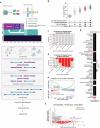A CRISPR/Cas9-based enhancement of high-throughput single-cell transcriptomics
- PMID: 40389438
- PMCID: PMC12089397
- DOI: 10.1038/s41467-025-59880-2
A CRISPR/Cas9-based enhancement of high-throughput single-cell transcriptomics
Abstract
Single-cell RNA-seq (scRNAseq) struggles to capture the cellular heterogeneity of transcripts within individual cells due to the prevalence of highly abundant and ubiquitous transcripts, which can obscure the detection of biologically distinct transcripts expressed up to several orders of magnitude lower levels. To address this challenge, here we introduce single-cell CRISPRclean (scCLEAN), a molecular method that globally recomposes scRNAseq libraries, providing a benefit that cannot be recapitulated with deeper sequencing. scCLEAN utilizes the programmability of CRISPR/Cas9 to target and remove less than 1% of the transcriptome while redistributing approximately half of reads, shifting the focus toward less abundant transcripts. We experimentally apply scCLEAN to both heterogeneous immune cells and homogenous vascular smooth muscle cells to demonstrate its ability to uncover biological signatures in different biological contexts. We further emphasize scCLEAN's versatility by applying it to a third-generation sequencing method, single-cell MAS-Seq, to increase transcript-level detection and discovery. Here we show the possible utility of scCLEAN across a wide array of human tissues and cell types, indicating which contexts this technology proves beneficial and those in which its application is not advisable.
© 2025. This is a U.S. Government work and not under copyright protection in the US; foreign copyright protection may apply.
Conflict of interest statement
Competing interests: During the course of this project and/or manuscript preparation, J.B., D.D., A.C., K.C., J.D., A.S., S.R., K.B., and J.A. were employees of Jumpcode Genomics. All other authors declare no competing interests.
Figures





References
MeSH terms
Grants and funding
- UL1TR002550/U.S. Department of Health & Human Services | NIH | National Center for Advancing Translational Sciences (NCATS)
- 20CDA35310187/American Heart Association (American Heart Association, Inc.)
- KL2 TR002552/TR/NCATS NIH HHS/United States
- UL1 TR002550/TR/NCATS NIH HHS/United States
- KL2TR002552/U.S. Department of Health & Human Services | NIH | National Center for Advancing Translational Sciences (NCATS)
LinkOut - more resources
Full Text Sources

